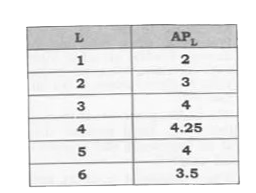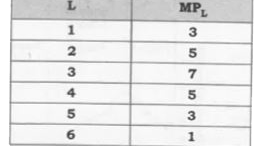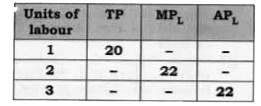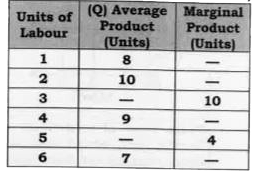Complete Solutions to NCERT TEXTBOOK QUESTIONS SOLVED of chapter PRODUCTION of Class 12 book with complete answers and questions
| Class 12 | ECONOMICS |
| Chapter | PRODUCTION |
| NCERT | NCERT TEXTBOOK QUESTIONS SOLVED |
| Number Of Questions | 86 |
| Academic Year | 2023-24 |
Explain the concept of a production function.
01:55View SolutionWhat is the total product of an input?
01:31View SolutionWhat is the average product of an input?
01:51View SolutionWhat is the marginal product of an input?
01:32View SolutionExplain the relationship between the marginal products and the total product of an input.
OR
Explain the law of variable proportion with the help of total product and marginal product curves.
OR
Explain the likely behaviour of Total Product and Marginal Product when for increasing production only one input is increased while all other inputs are kept constant.
OR
State the different phases of changes in Total Product and Marginal Product in the Law of Variable Proportions. Also show the same in a single diagram.View SolutionExplain the concepts of the short run and the long run.
02:06View SolutionWhat is the law of diminishing marginal product?
01:22View SolutionWhat is the law of variable proportions?
OR
Define the law of variable proportion.02:01View SolutionWhen does a production function satisfy constant returns to scale?
00:58View SolutionWhen does a production function satisfy increasing returns to scale?
01:19View SolutionWhen does a production function satisfy decreasing returns to scale?
01:13View SolutionThe following table gives total product schedule of labour. Find average product and marginal product schedules of labour.
 03:58View Solution
03:58View SolutionThe following table gives the average product schedule of labour. Find the total product and marginal product schedules. It is given that the total product is zero at zero level of labour employment.
 View Solution
View SolutionThe following table gives the marginal product schedule of labour. It is also given that total product of labour is zero at zero level of employment. Calculate the total and average product schedules of labour.
 View Solution
View SolutionLet the production function of a firm be `Q=5L^(1//2)K^(1//2)` . Find the maximum possible output that the firm can produce with 100 units of L and 100 units of K.
01:40View SolutionLet the production function of a firm be `Q=2L^(2) K^(2)`. Find out the maximum possible output that the firm can produce with 5 units of L and 2 units of K. What is the maximum possible output that the firm can produce with zero unit of L and 10 units of K?
View SolutionFind out the maximum possible output for a firm with zero unit of L and 10 units of K when its production function is `Q=5L + 2K`
View SolutionExplain the concept of a production function.
01:55View SolutionIn which run some factors of production are fixed and others are variable?
View SolutionWhat change will take place in marginal product when total product increases at a diminishing rate?
View SolutionIn which phase of Law of Variable Proportions a rational firm aims to operate?
View SolutionWhat is meant by diminishing returns to a factor?
View SolutionWhat is the general shape of the AP and MP curves?
View SolutionHow does fall in marginal production affect total output?
View SolutionWhy MP curve cuts AP curve at its maximum point?
View SolutionCan AP rise when MP starts declining?
View SolutionWhat is the shape of AP and MP?
View SolutionGive meaning of "Return to a Factor".
View SolutionThe marginal product of a variable input is best described as:
View SolutionDiminishing marginal returns implies:
View SolutionThe short run, as economists use the phrase, is characterized by:
01:19View SolutionThe marginal, average, and total product curves encountered by the firm producing in the short run exhibit all of the following relationships except:
View SolutionTo economists, the main difference between short run and long run is that:
01:29View SolutionWhich one of the following statements is the best definition of production function?
02:06View SolutionDiminishing returns occur:
01:38View SolutionIf the marginal product of labour is below the average product of labour, it must be true that:
View SolutionThe average product of labour is maximized when marginal product of labour:
01:28View SolutionThe law of variable proportions is drawn under all of the assumptions mentioned below except the assumption that:
01:46View SolutionAverage product is defined as:
01:13View SolutionThe change in the total product resulting from a change in a variable input is:
02:59View SolutionMarginal product, mathematically, is the slope of the
02:07View SolutionDiminishing marginal returns for the first four units of a variable input is exhibited by the total product sequence:
View SolutionDifferentiate , between Short Period and Long Period.
02:19View SolutionDifferentiate between Short Period production and Long Period production function .
02:26View SolutionExplain the relationship between Marginal product and Average Product.
OR
State the relation between Marginal product and average product. Use diagram.View SolutionExplain the relationship between Total Product and Average Product.
01:30View SolutionExplain the relationship between Total Product, Average Product and Marginal Product.
02:13View SolutionWhat is the reaction of AP, when:
(i) MP is more than AP.
(ii) MP is less than AP.
(iii) MP is equal to AP.01:24View SolutionWhat is the behaviour of TP, when
(i) MP rises
(ii) MP falls, but remains positive
(iii) MP is zero
(iv) MP becomes negative?02:25View SolutionComplete the following table.
 View Solution
View SolutionComplete the following table.
 View Solution
View SolutionComplete the following table:
 View Solution
View SolutionWhat is the law of variable proportions?
OR
Define the law of variable proportion.02:01View SolutionComplete the following table:
 View Solution
View SolutionWhen the quantity of a variable input is increased from 3 units to 4 units, the total output increases from 70 units to 85 units. The marginal product of the variable input is 15 units.
View SolutionWhen the quantity of a variable input is increased from 4 to 6 units, the total output increases from 85 units to 105 units. The marginal product of the variable input is 20 units.
View SolutionWhen the marginal product of a variable input falls, total product also falls.
01:28View SolutionWhen there are diminishing returns to a factor, total product always decreases.
01:11View SolutionTotal product will increase only when marginal product increases.
01:33View SolutionIncrease in total product always indicates that there are increasing returns to a factor.
01:14View SolutionWhen there are diminishing returns to a factor, marginal and total product both always fall.
01:16View SolutionWhen there are diminishing returns to a factor, total product first increases and then starts falling.
01:17View SolutionTotal product always increases whether there is increasing returns or diminishing returns to a factor.
01:14View SolutionIf marginal product rises, average product must also rise.
01:04View SolutionIf marginal product falls, average product must also fall.
01:04View SolutionIf marginal product becomes negative, average product must also become negative.
01:11View SolutionAverage product will increase only when marginal product increases.
OR
Average product rises only where marginal product rises.01:15View SolutionUnder diminishing returns to a factor, total product continues to increase till marginal product reaches zero.
01:29View SolutionState the behaviour of marginal product in the law of variable proportions. Explain the causes of this behaviour.
Or
Giving reasons, explain the law of variable proportion.
Or
What are the different phases in the Law of Variable Proportions in terms of marginal product? Give reason behind each phase. Use diagram.View SolutionIf diminishing marginal returns will set in after the very first unit of labour is employed? What do the average product, and marginal product curves look like in this case ?
View SolutionExplain the differences between variable factors and fixed factors.
01:17View SolutionExplain how is it possible for marginal product to fall while average product is rising?
01:30View SolutionAssume the marginal product for a particular good is constant. Describe the shape of the total product function that would accompany it.
View SolutionComment on the following statement: "When average product and marginal product are equal, marginal product is at its maximum."
01:32View SolutionComment on the following statement: "Diminishing returns occur when total output falls as additional units of labour are combined with fixed inputs in the production process."
01:26View SolutionA farmer in Punjab transports wheat from the farm to a flour mill. Is this activity considered as production? Why?
01:05View SolutionHow can the productivity of Human resources be increased?
01:07View SolutionAvailability of agricultural land (fixed factor) is limited in the world, but demand of food grain is continuously increasing. Is it possible to increase the supply of food grains by continuously increasing variable factors like seeds, fertilizers etc.?
01:41View SolutionThough the contribution of plastic industry in GDP is more, yet why is it not considered an Index of social welfare?
01:55View SolutionWhich one of the following will be treated as labour in economics? Give a reason for each.
(i) Preparation of food by a housewife.
(ii) Singing for one's own pleasure.
(iii) Driving his master's car by a driver.
(iv) Playing cricket by Virat Kohli.01:47View SolutionWhat efforts should be made in an economy for the continuous use of exhaustible natural resources in production?
01:53View SolutionThe data below shows the relationship between total output and the amount of labour hired at Papa's Pizza Shop

Does the production function in the above table exhibit diminishing marginal returns?View SolutionGive reasons for the following statements:
(i) Variable factor proportions obtain in the short run.
(ii) Fixed factor proportions obtain in the long run.02:13View SolutionIf the total product curve is a straight line through the origin, what would be the shape of the average product and marginal product curves look like?
View SolutionExplain the differences between variable factors and fixed factors.
01:17View SolutionGive reasons for the following statements:
(i) Variable factor proportions obtain in the short run.
(ii) Fixed factor proportions obtain in the long run.02:13View Solution
NCERT TEXTBOOK QUESTIONS SOLVED questions and complete solutions for chapter PRODUCTION of FULL MARKS ECONOMICS (HINGLISH) of Class 12
